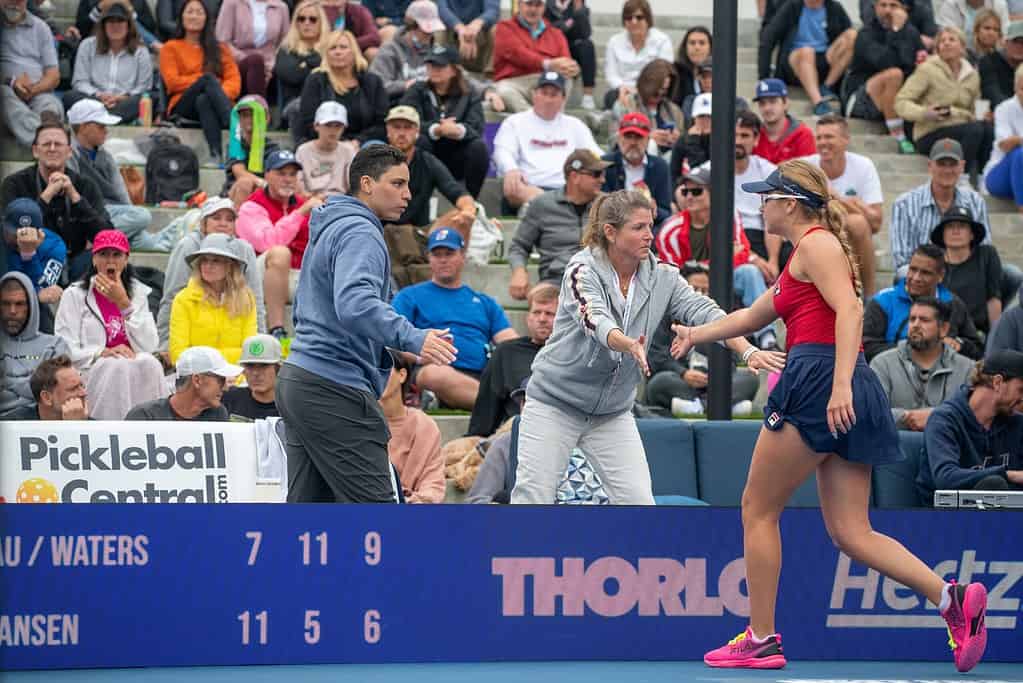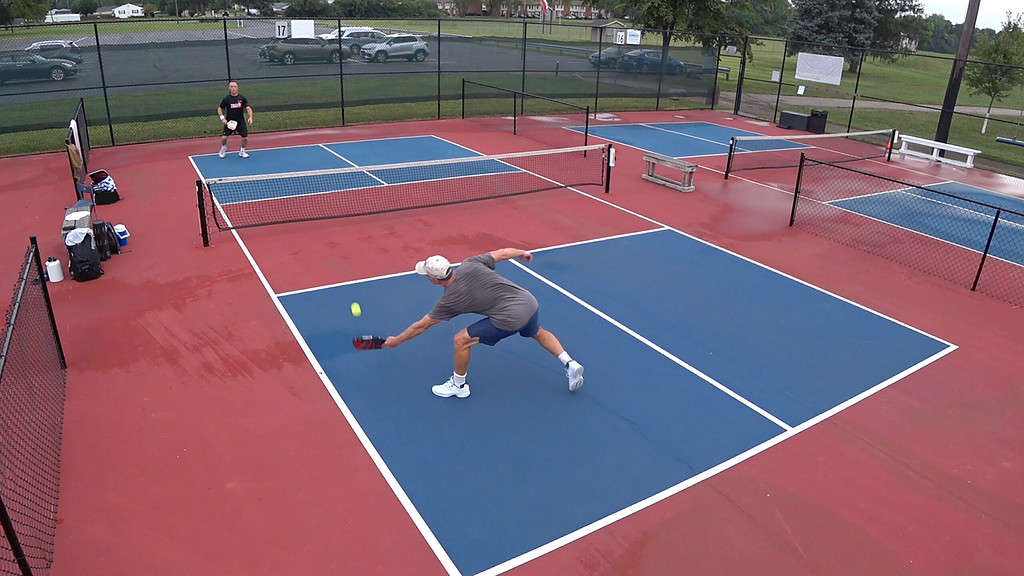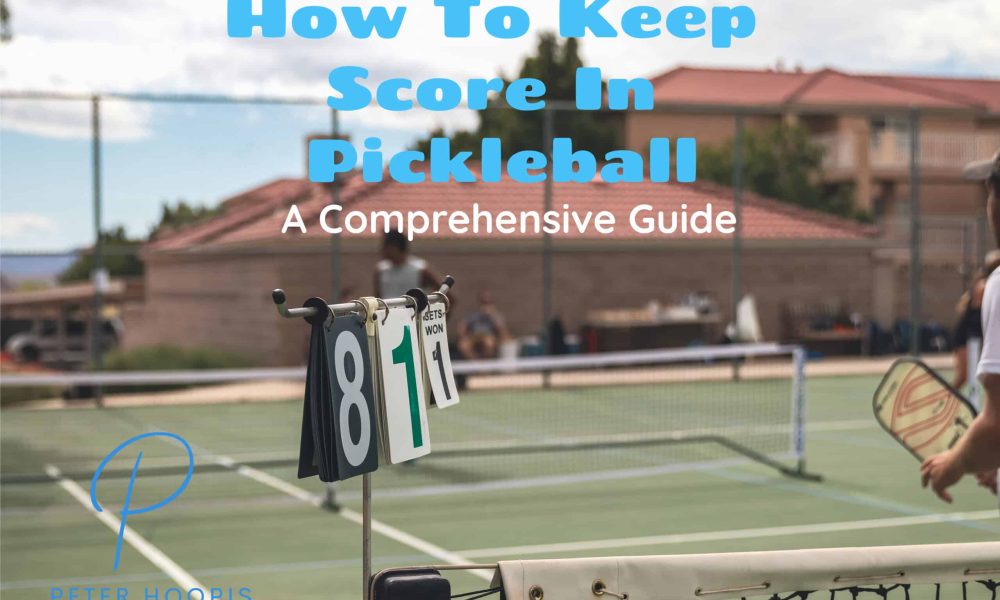Pickleball is a fun game that’s a mix of tennis, badminton, and table tennis. But to really get the most out of it, you need to know how pickleball scoring works. That’s what this blog post is all about. We’re going to break down the scoring rules in simple, easy-to-understand steps.
By the end of this post, you’ll know exactly how to keep score in pickleball.
So, let’s get started and learn more about this exciting game!
How To Keep Score In Pickleball
To keep score in pickleball may seem a bit tricky at first, but once you get the hang of it, it’s pretty straightforward. Here are the basics:
- Points: In pickleball, you can only score points when serving. If the serving team wins the rally, they get a point. If the receiving team wins, they don’t get a point, but they do get the serve.
- Serving: Each game starts with one player from the serving team serving diagonally to the opponent’s court. The server must keep one foot behind the baseline during the serve. The ball must bounce once on each side before volleys (hitting the ball before it bounces) are allowed.
- Double Bounce Rule: After the serve, each team must play their first shot off the bounce. That is, the receiving team must let the serve bounce and the serving team must let the return of serve bounce before playing it. This is known as the double bounce rule.
- Faults: A fault can occur in several ways such as hitting the ball out of bounds, stepping into the non-volley zone and volleying the ball, or failing to hit the ball over the net.
- Pickleball Scoring Format: The score in pickleball is generally called out in a three-number format, for example, 4-2-1. The first number represents the serving team’s score, the second number is the receiving team’s score, and the third number indicates if the server is the first or second server for their team (in doubles play).
- Winning the Game: A standard game of pickleball is played to 11 points, and the winning team must win by at least 2 points.
Remember, like any sport, the best way to understand and get comfortable with the scoring is by playing the game regularly!
Understanding the 11-Point Pickleball Scoring System

The 11-point pickleball scoring system is the standard format for a game of pickleball. It might seem a bit complex at first, but once you get the hang of it, it becomes second nature.
Here’s how it works:
In pickleball, only the serving team has a chance to score points. If the serving team wins a rally, they earn a point and continue to serve. If the receiving team wins the rally, no points are awarded, but they get to serve next.
Starting the Game: The game begins with one team serving from the right-hand side of the court. The server serves diagonally to the receiver on the opposite side. The server must let the ball bounce once before returning it, and similarly, the receiver must also let the ball bounce once before returning the serve. This is known as the “double bounce rule”.
Scoring Points: If the serving team wins the rally, they score a point and the server moves to the left-hand side of the court to serve again. The players continue to alternate sides each time they score a point. If the receiving team wins the rally, they don’t score a point, but they get the serve. The new serving team doesn’t switch sides to serve.
Calling the Score: The score is typically called out in a three-number sequence: the server’s score, the receiver’s score, and whether the server is the first or the second server (in doubles). For example, if the server says “4-2-2”, it means the serving team has 4 points, the opposing team has 2 points, and the second player on the serving team is serving.
Winning the Game: The game continues until one team scores 11 points and is at least 2 points ahead. If both teams reach 10 points, then play continues until one team leads by 2 points, which could extend the game beyond 11 points.
That’s the basics of the 11-point scoring system in pickleball.
Serving Team Advantages

In pickleball, the serving team has several key advantages that can be leveraged to control the game. Here are a few:
- Scoring Opportunities: Only the serving team has the opportunity to score points. If the serving team wins the rally, they earn a point. This means that the serving team always has a chance to increase their lead or close a gap in the score.
- Serve Control: The server has control over the start of the rally. They can decide the speed and location of the serve, which can be used to put the receiving team on the defensive from the outset.
- Double Chance in Doubles: In doubles play, each team gets two chances to serve (one for each player) before the serve switches to the other team. This means the serving team has twice as many opportunities to score points before they risk losing the serve.
- Initiative: The serving team sets the pace of the game. They can choose to slow down or speed up the game based on their serve, potentially disrupting the rhythm of the opponents.
- Positioning: After the serve, the serving team has the opportunity to move forward and take control of the net, which is a strategic advantage in pickleball.
Remember, while these advantages can help, winning in pickleball also heavily depends on skill, strategy, and teamwork!
How To Keep Score in Pickleball Doubles: Key Rules and Concepts

Doubles scoring in pickleball is a little more complex than singles scoring due to the addition of a second server. Here are the key rules and concepts:
- Two Servers: Each team gets two serves per turn, one for each player. The first server starts from the right-hand side and continues serving until they commit a fault. Then, the second server starts serving from the left-hand side until they commit a fault. After both players have served and the serving team loses, the serve switches to the other team.
- First Serve of the Game: At the start of the game, only one player from the starting team gets to serve before the serve switches to the other team. This is the only time in the game when only one player from a team serves.
- Scoring: Like in singles play, only the serving team can score points. If the serving team wins a rally, they score a point and continue to serve. The server switches sides with their partner after each point scored. If the receiving team wins a rally, no points are awarded, but the second server gets a chance to serve. If both servers lose their serve, the serve switches to the other team.
- Calling the Score: The score is called out as three numbers: the serving team’s score, the receiving team’s score, and whether the server is the ‘first’ or ‘second’ server for their team. For example, “7-5-2” means the serving team has 7 points, the receiving team has 5 points, and the server is the second server.
- Winning the Game: A standard doubles pickleball game is played to 11 points, but a team must win by at least 2 points. If both teams reach 10 points, play continues until one team has a 2-point lead.
These are the basics of doubles scoring in pickleball.
First Server Exception Rule Explained
The first server exception rule in pickleball is a unique rule that applies only to the very start of the game. Here’s how it works:
In doubles play, each team typically gets two serves per turn – one for each player. The first server serves until they commit a fault, then the second server serves until they commit a fault. After both players have served and lost their serve, the serve switches to the other team.
However, at the start of the game, only one player from the starting team serves before the serve switches to the other team. This player is often referred to as the “first server.” After this initial serve, the game proceeds with each team getting two serves per turn, one for each player.
This rule is often called the “first server exception” or “one serve rule at start,” and it’s an important part of understanding how serving works in pickleball doubles. Once the game is in progress, this exception no longer applies, and both members of each team will serve in turn when it’s their team’s turn to serve.
Alternating Serves and Sideout Rules
In pickleball, the concepts of alternating serves and side outs are fundamental to the flow of the game. Here’s how they work:
Alternating Serves:
In both singles and doubles play, the server switches sides of the court after each point won. They start serving from the right-hand side (when their score is even), and after scoring a point, they move to the left-hand side (when their score is odd) for the next serve. This continues until they commit a fault.
In doubles, once the first server commits a fault, the serve passes to the second player on the team, and they begin serving from the right-hand side, regardless of the team’s score. They serve until they commit a fault, alternating sides after each point scored.
Side Outs:
A “side out” occurs when the serving team commits a fault and both players on the serving team have had their turn at serving (in doubles play). A side out means the serve passes to the other team. The receiving team becomes the serving team, and they now have the opportunity to score points. In doubles, the player on the right-hand side of the court always serves first when their team wins the serve.
Remember, only the serving team can score points in pickleball, so alternating serves and achieving side outs are key strategic elements of the game.
Pickleball Singles Scoring: Differences and Similarities

Singles scoring in pickleball is similar to doubles scoring in many ways, but there are also some key differences. Here’s a breakdown:
Similarities:
- Scoring Opportunities: In both singles and doubles, only the serving player or team can score points. The server continues to serve as long as they keep winning points.
- Serve Sequence: The server starts from the right-hand side of the court when their score is even and serves from the left-hand side when their score is odd. This holds true for both singles and doubles.
- Winning the Game: In both singles and doubles, a standard game is played to 11 points, but a player or team must win by at least two points.
Differences:
- Number of Servers: In singles, there’s only one server per side, so when the server loses a point, the serve switches to the other player. In doubles, each side gets two serves (one for each player) before the serve switches to the other team.
- Calling the Score: In singles, the score is called with just two numbers: the server’s score first, then the receiver’s score. For example, “5-3” means the server score is 5 points and the receiver score is 3 points. In doubles, a third number is added to indicate whether the server is the first or second server for their team.
- Movement and Strategy: Singles play typically involves more movement and endurance, as each player is responsible for their entire side of the court. The strategies used in singles may also differ from those in doubles due to the difference in court coverage.
Despite these differences, the basic rules of pickleball remain the same whether you’re playing singles or doubles. The game requires skill, strategy, and agility, and it’s a great way to have fun and stay active.
Singles Serving Positions
Serving positions in pickleball singles are based on the score of the server. Here’s how it works:
- Starting Serve: The player who serves first in the game starts from the right-hand side of the court. This is known as the “even” side because the server will serve from this side whenever their score is an even number.
- Alternating Sides: After each point scored, the server switches sides. They serve from the right-hand side (even side) when their score is an even number and from the left side (odd side) when their score is an odd number.
- After a Fault: If the server makes a fault (for example, hits the ball out of bounds or into the net), the serve switches to the other player. The new server then starts serving from the right-hand side if their score is even, or the left-hand side if their score is odd.
- Calling the Score: Before each serve, the server calls out the score, saying their score first and then the opponent’s score. For example, “5-3” means the server has 5 points and the receiver has 3 points.
Remember, in pickleball singles, the entire court is in play, and players must move quickly to cover it. Understanding serving positions and using them strategically is an important part of the game.
No Server Number in Singles
Unlike doubles pickleball, singles play does not have a server number or a server’s score in its scoring system. Each player has only one serve, eliminating the need for the third number in the score. This simplification of the scoring process allows players to focus more on their gameplay and strategy without having to keep track of server numbers.
Understanding this distinction between singles and doubles scoring will help you adapt to both formats of the game seamlessly. And don’t forget about skinny singles!
Calling the Score: Best Practices and Common Mistakes
Calling the score in pickleball is a crucial part of the game, as it keeps all players aware of the game’s status. Here are some best practices and common mistakes:
Best Practices:
- Speak Clearly: Call the score loudly and clearly before every serve so that all players can hear.
- Correct Order: The score should always be called in the correct order: the serving team’s score first, then the receiving team’s score, and finally the server number (in doubles).
- Pause After Calling the Score: Wait for a moment after calling the score before you serve. This gives everyone a chance to agree on the score or correct it if necessary.
- Practice: If you’re new to the game, practice calling the score at home or during friendly games. It will become second nature with time.
Common Mistakes:
- Forgetting the Server Number: In doubles, it’s easy to forget to call the server number. Remember, “1” refers to the first server and “2” to the second server.
- Wrong Order: Some beginners call the receiver’s score before the server’s score. Always remember: server’s score first.
- Not Waiting After Calling the Score: Some players rush to serve right after calling the score. It’s important to pause and make sure everyone agrees on the score before serving.
- Not Calling the Score: Sometimes, players forget to call the score altogether. This can lead to confusion and disputes, so it’s best to get into the habit of always calling the score before each serve.
Remember, accuracy in calling the score helps maintain a fair and enjoyable game for everyone involved.
Proper Score Announcements
Correctly announcing the score in pickleball is crucial for a smooth game and maintaining good sportsmanship.
In singles play, the server should call their score first, followed by the receiver’s score.
In doubles, the serving team’s score should be stated first, followed by the receiving team’s score, and then the serving team’s current serve number.
Following these guidelines will help avoid confusion and ensure that all players are on the same page.
Remember that failing to announce the serve in pickleball is considered a fault. By consistently calling the score before each serve, you can not only avoid faults but also maintain a clear understanding of the game’s progress. Proper score announcements contribute to a fair and enjoyable experience for all players involved.
Correcting Errors in Score Calling
Correcting errors in score calling during a pickleball game is important to maintain fair play. Here’s what you can do if an error is detected:
- Speak Up Immediately: If you notice that the server has called the wrong score, it’s essential to correct them immediately before the next serve. Politely point out the error and provide the correct score.
- Agreement Among Players: All players should agree on the correct score before proceeding with the game. If there’s disagreement, try to resolve it by discussing the points that each player remembers.
- Replay the Point: If the players cannot agree on the correct score, in casual play, they may decide to replay the point. However, in official tournaments, the referee would make a final decision.
- Keep Track of Score: To avoid confusion, it’s a good practice for all players to keep track of the score throughout the game.
- Practice Score Calling: Regularly practicing score calling can help minimize errors. This includes stating the serving team’s score first, then the receiving team’s score, and finally the server number (in doubles).
Remember, maintaining a friendly and respectful attitude when correcting score errors is key to keeping the game enjoyable for everyone.
Tips for Keeping Track of Your Position and Score
Keeping track of your position and score in pickleball can be challenging, especially for beginners. Here are some tips to help:
Keeping Track of Position:
- Remember Your Side: Always remember which side you should be serving from. In both singles and doubles, serve from the right-hand side when your score is even and the left-hand side when your score is odd.
- Watch Your Opponents: Pay attention to your opponents’ positions. This will not only help you strategize your shots but also remind you of where you should be on the court.
- Use Visual Cues: Some players find it helpful to use visual cues, like a specific mark on the court, to help them remember their correct position.
Keeping Track of Score:
- Call Out the Score: Make a habit of calling out the score before each serve. This helps everyone stay aware of the current score.
- Confirm the Score: After each point, confirm the score with your partner (in doubles) or opponent (in singles) before proceeding.
- Use Physical Reminders: Some players find it helpful to use physical reminders to keep track of the score. For example, you might move a small object from one pocket to another each time you score a point.
- Practice: The more you play, the better you’ll get at keeping track of the score and your position. Practice makes perfect!
Remember, accuracy in keeping track of your position and score is important for fair play and strategic gameplay.
The Even Right, Odd Left Rule
The “even right, odd left” rule in pickleball refers to the serving positions based on the server’s score. Here’s how it works:
- Even Right: When the server’s score is an even number (including zero), they serve from the right-hand side of the court.
- Odd Left: When the server’s score is an odd number, they serve from the left-hand side of the court.
This rule applies to both singles and doubles games.
Summary
Mastering the art of scoring in pickleball is essential for players of all skill levels. By understanding the fundamentals of the 11-point system, serving rules, and the differences between singles and doubles scoring, you can elevate your gameplay and enjoy a more competitive experience on the court. Keep at it and in no time you will have mastered the pickleball scoring rules!
Frequently Asked Questions
Get answers to a list of the most Frequently Asked Questions.
When playing pickleball, it is important to remember that the team who starts the game on the right side of the court is considered the “even” team. Whenever the even team scores a point, their score will be an even number, while the odd team will have an odd number.
Keeping track of which team is even and which one is odd will help you keep track of the score throughout the game.
Yes, points can only be scored when serving in pickleball. At the start of a game, the server on the right (even court) serves to the diagonally opposite court. The receiving side cannot score a point.
If the server scores a point, they then switch to the left side (odd court) and serve to the diagonally opposite court.
In pickleball, 002 refers to the beginning of the game when the server will score points if their opponent commits a fault. Consequently, the receiver’s team has an opportunity to be the first team to start scoring.


